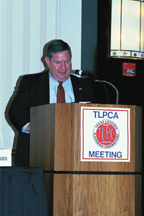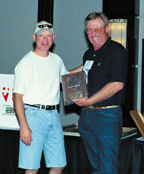

Held at the Capitol Marriott, approximately 20 exhibitors helped celebrate the association's history with key figures President Mike Mays and Executive Director Wayne James, among the membership of the TLPCA. Apart from the festivities that the association is known for, its education program contained a roster from state officials, presidents and CEOs of manufacturers, among others.
Beginning the program's education session was an introduction from Texas' Secretary of State Gwyn Shea. Offering an extended welcome to the members, Shea's opening speech was largely a congratulatory note to the association.
"For half a century, the TLPCA has been playing an important role in meeting the needs of hardworking contractors," she said. "It serves as an important networking and continuing education resource for members. It has helped make sure that issues that are important to plastering and lathing contractors are heard in Austin."
Next on the association's list of speakers was Jose Montemayor, the Commissioner of Insurance for the State of Texas. In the tone of optimism, Montemayor presented no fa¿e of the plague ailing contractors within the EIFS industry. Opening with remarks about how it is interesting to visit contractors vs. his more common speaking engagements with insurance sellers, he wasted no time addressing the facts.
"It should be apparent ¿ that I'm not bringing you a phony, feel-good message about general liability coverage of EIFS," he says. "I wish there were an easy answer, but there is not.
"Insurance industry reluctance to cover EIFS has much to do with an issue that I'm ¿ intimately acquainted with. That issue ¿ is mold and its impact on insurance availability and affordability."
Acknowledging the sensitivity, complexity, and frustration surrounding insurance and the mold issue, Montemayor suggested tips that may help the contractor acquire insurance and methods of smart business that would reduce a lot of headaches that would present obstacles for those in the trade.
Four key points included to help the contractor: First, to keep up risk management efforts by training and supervision; second to educate the insurance agency about EIFS; third, shop for surplus lines agents who can search the London market for coverage, and; fourth, consider forming a risk retention group to provide general liability coverage for EIFS.
Further in his speech, he commented on how he's hopeful the mold issue is waning and that homeowners won't have a need to spend top dollar in the future for coverage because of mold-related water claims. Montemayor further predicted that the 2003 Texas Legislature will be working for state licensing of mold remediators, regulation of rates charged by residential property insurers and control of insurers' use of credit scoring before closing.
CEO and current EIMA President, Macon Lowe, of STO Corp., and Dryvit's President and EIMA's Immediate Past President, Peter Balint, shared the stage to continue the discussion on the insurance crisis and to reflect and examine the industry as it stands today. Dividing their time, the two offered both criticisms and thoughts on where the industry's at and where it's headed.
"Well, our commercial business is growing," said Lowe. "The litigations seem to be winding down. The lawyers aren't suing us as often. The insurance industry as a whole-whether it's insurance on homeowners or gynaecologists, whoever-people are having a hard time dealing with increases in premiums and exclusions in coverage."
"I think the future of EIFS looks good, though we're (the industry) having a hard time right now," said Balint. "I think insurance will work itself out."
Following an introduction that was positive, Lowe continued to remark on some improvements he hopes others-both in and out of the industry-could practice.
"ICBO: I don't think initially they were very supportive, though they're getting better," he said. "The window industry also was not very favorable, though we just had a meeting and they'd like to form an alliance and come up with some standards to address water intrusion."
He went on to report that EIMA's Steve Klamke is currently working with the insurance companies to find some solutions regarding coverage.
With a relevant pick up to where the industry pillars of EIFS left was Tina Bramlett, technical director of Teifs Wall Systems. Her speech was on the developments and modifications with the numerous building codes titled, "How the Recent Changes in the Building Codes Will Affect Stucco, Metal Lath, EIFS and Your Firm in the Future."
She outlined some of the changes and modifications regarding codes from IBC, BOCA, SBC and UBC, among others. Among the topics covered were IBC's requirements on barrier and drainage systems for not just EIFS, but all exterior wall envelopes. Also, Bramlett presented the latest states to adopt IBC and IRC's codes.
To celebrate its 50th anniversary, the TLPCA has issued a Distant Learning educational CD-ROM program titled the "Introduction to Portland Cement Plaster/Stucco." To obtain a copy, contact the TLPCA.


Report Abusive Comment